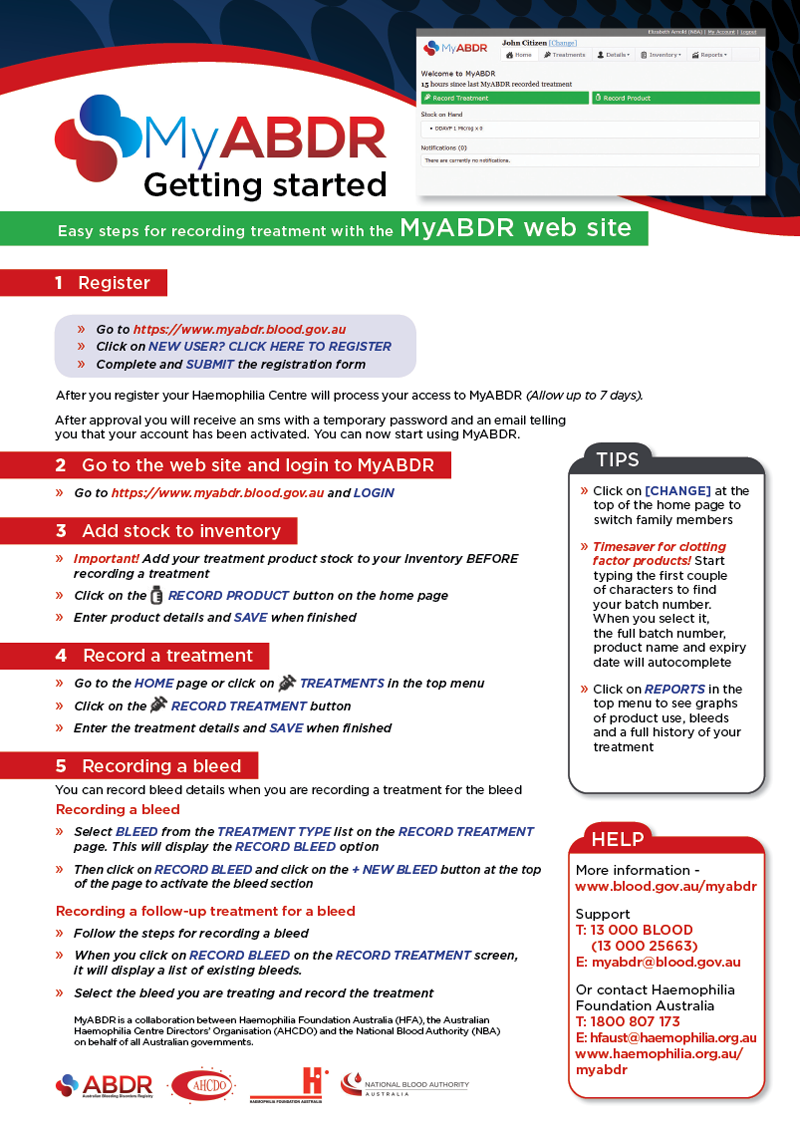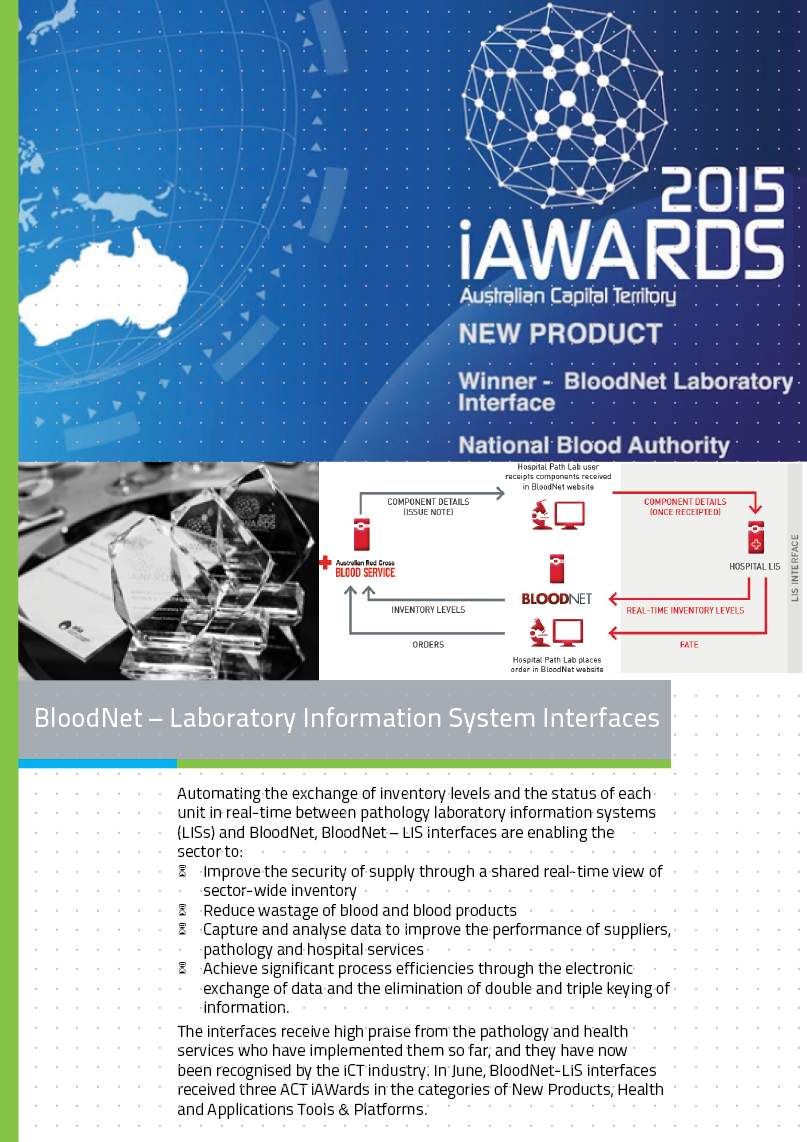Objective 2. Improve risk management and blood sector performance
In 2014-15, the NBA achieved a range of objectives to improve blood sector performance and risk management, particularly in the areas of Ig governance, evaluation of new products, ICT developments, data availability and analysis and risk and knowledge management.
Ig Governance
The NBA made significant progress to implement new Ig authorisation and clinical governance arrangements. These arrangements will address a range of deficiencies identified in the 2012-13 review of the management of Ig, including:
- significant variations and inefficiencies in Ig management processes nationally
- variation in dosing
- high prescription rates in some conditions compared to international rates of use
- limited transparency of price implications
- no accountability for cost with the prescriber.
Key 2014-15 achievements included:
- establishment of a network of new national specialist advisory committees to assess and recommend changes to the arrangements for the supply of Ig in Australia
- publication and implementation of new Ig Governance policies, a standardised patient treatment review process and revised forms
- review of the Criteria for the clinical use of intravenous immunoglobulin in Australia (Criteria) for adaption to the new information management system under development, BloodSTAR.
Strengthening Immunoglobulin (Ig) product authorisation and management (text version)
Immunoglobulin products, derived from pooled human plasma, are a precious and high cost resource. Strengthening immunoglobulin product authorisation and management is a priority for the National Blood Authority (NBA), and a number of measures are being developed to ensure the sustainability of these products into the future.
The National Immunoglobulin Governance Advisory Committee (NIGAC), established to provide advice and make recommendations to the NBA and Jurisdictional Blood Committee (JBC) to support cost effective and clinically appropriate governance, held its inaugural meeting in August 2014. The Specialist Working Groups (SWGs) for Haematology, Immunology, Neurology and Solid Organ Transplantation have also been established to provide clinical expert advice and recommendations on the work to further evolve the Criteria for the clinical use of intravenous immunoglobulin in Australia, assess and improve the performance of the governance system and identify improvements to systems and processes.
The National Policy: Access to Government Funded Immunoglobulin Products in Australia was implemented in November 2014 (except Western Australia). The national policy clarifies the roles, responsibilities, authority and accountability of those nivolved in authorising, supplying, managing and using immunoglobulin products throughout the supply chain and within health services, including:
- new Authorisation Request Forms, with patient consent to the collection, retention and use of their personal and sensitive information in line with the requirements of the Australian Privacy Principles (APPs);
- the provision of information required to support initial and continuing therapy;
- standardised national patient treatment review process with revised forms and timeframes for providing information to support access requests for continuing therapy;
- coordinated in-hospital ordering and management to improve transparency of product inventory, to ensure that product is provided to approved patients only and to reduce expiry related wastage.
BloodSTAR, a System for Tracking Authorisations and Reviews, is currently under development by the National Blood Authority. BloodSTAR underpins the roles and responsibilities set out in the National Policy, and will manage, standardise and improve the supply of immunoglobulin products for the treatment of conditions identified in the Criteria. BloodSTAR will replace the Blood Service's STARS system which has been used for a number of years to manage authorisation and review obligations.
BloodSTAR extends system capability from authorisers to also include prescribers, nurses/midwives and dispensers, closing the information loop on the delivery of care to patients and product management. BloodSTAR User Reference Groups (BSURG) have been established to provide an avenue for stakeholder consultation and user acceptance testing. These groups have assisted with the design and user experience for system capability associated to the four key user groups represented in the Nationa l Policy, involving Prescribers, Authorisers, Nurses/Midwives and Dispensers
BloodSTAR will be formally launched in 2016, with a transition period commencing in late 2015. Prescribers, authorisers and nurses/midwives will access BloodSTAR through a web interface that is reached through the NBA's BloodPortal. Dispensers will access the system through a new Authorisation module in BloodNet.
Under the guidance of the national network of committees and utilising the Criteria and governance policies and data derived from BloodSTAR, a program will be developed to monitor, assess and improve the performance of the governance system. This wi ll include the development of better knowledge to support more informed decision making both at the clinician and system-wide management levels, to improve clinical practice, governance and management.

Evaluation of new products
The working group established by the JBC, including NBA and jurisdictional representatives, progressed work on the requirements and processes for evaluations to be undertaken under Schedule 4 of the National Blood Agreement.
Following an NBA evaluation, the JBC endorsed a proposal for C1 esterase to be referred to the Medical Services Advisory Committee (MSAC) for consideration of a health technology assessment and possible inclusion on the National Supply List. MSAC is expected to have completed its review early in 2015-16 for consideration by JBC in December 2015.
Data developments
In 2014–15, the NBA continued to build its data capture and analysis capabilities across all aspects of the supply chain. This area of activity is a key strategy to improve the overall efficiency and sustainability of the sector by providing a measurement for improvement.
A significant amount of data and information exists within the blood sector, however, the extent to which this data is currently available to the parties that need it, the quality of the data, and the capacity of the systems that hold it, varies widely. The adoption of a data visualisation and analysis tool has significantly enhanced the NBA's ability to harness data across all data domains managed by the NBA.
During 2014-15, the NBA progressed the following activities identified in the National Blood Sector Data and Information Strategy and Scorecard 2013-2016:
- Agreed a list of BloodNet and ABDR reports to be provided to stakeholders and developed specifications to assist in their development
- Discard Data
- Collected, analysed and distributed discard data from the BloodNet Fate Module to support the establishment of targets for discard rates in 2015-16 under the National Blood and Blood Product Wastage Reduction Strategy 2013-2017.
- Specified BloodNet discard reports and management reports were launched to jurisdictions and health providers.
- Haemovigilance
- Published the National Haemovigilance Report 2015 based on data for 2011-12 and 2012-13 collected by states and territories.
- Developed and gained JBC approval of the Strategic Framework for the National Haemovigilance Program.
- Developed and distributed haemovigilance tools and templates to support haemovigilance programs in Queensland and Western Australia.
- Developed standards and minimum data sets for haemovigilance reporting.
- Australian Bleeding Disorders Registry (ABDR)
- Published the ABDR Annual Report for 2013-14.
- Continued to develop the AHCDO draft Benchmarking Report.
- Developed a data extract for Haemophilia Treatment Centre staff to review as part of the data integrity process of the ABDR which will be implemented in early 2015-16.
- Signed an agreement for Red Cell Data Linkage arrangements with South Australia and progressed a further agreement with Queensland. These agreements form the prototype for the remaining jurisdictions. In addition, standards and minimum data sets for transfusion/use reporting by DRG and procedure and red cell data linkage were developed.
- Developed the National Blood Sector Data and Information Governance Framework, which was approved by the JBC in late 2014 and is now available on the NBA website.
- Published the National Scorecard 2013-14.
- Published the Ig Annual Report for 2013-14.
Risk management
The management of blood sector risk remains a core element of ensuring the security and availability of the blood supply.
2014-15 saw the NBA complete three major activities to further strengthen risk management arrangements relating to:
- the National Blood Supply Contingency Plan
- blood sector risks, particularly as they relate to liability provisions under the Deed with the Red Cross
- supply risk mitigation arrangements for plasma derived and recombinant products.
National Blood Supply Contingency Plan (NBSCP)
The NBSCP is a cornerstone measure to manage risks to the blood supply. In 2014-15 a range of activities were undertaken to further strengthen contingency management arrangements, including the following:
- A comprehensive revision of the NBSCP to take into account a range of contingency management enhancements approved by JBC in relation to a new annex dealing with the management of a shortage of supply of platelets. The revised NBSCP will be considered for endorsement by the JBC in December 2015.
- The conduct of a NBSCP contingency exercise with the Blood Service in April 2015 to test new arrangements for the management of a national shortage of supply of platelets.
Review of Risk Management in the Blood Sector
The NBA progressed a range of recommendations resulting from an independent comprehensive Review of Risk Management in the Blood Sector, previously known as the National Managed Fund (NMF) Action Plan Review. This included approval of strategic level recommendations by all Health Ministers through the COAG Health Council. The Review concluded that the overall level of risk in the blood sector has reduced over the last decade due to a range of factors, including supply security improvements undertaken by the NBA. The recommendations approved by Ministers will further strengthen supply security and address some outstanding Red Cross concerns relating to risk exposure in negotiating a new Deed of Agreement. Concurrently, the NBA progressed a range of operational improvements for implementation in consultation with the Blood Service.
Supply Risk Mitigation for Plasma Derived and Recombinant Products
The NBA completed a Supply Risk and Mitigation Project to review supply security arrangements for all plasma derived and recombinant products. This included the validation of existing stock and contractual supply reserves.
Information Communication Technology (ICT) developments
ICT systems development and operations continue as a key enabler of both data collection/analysis and business process reform across the sector.
The NBA continued to pursue outcomes identified in the JBC-approved National Blood Sector ICT Strategy 2013-16 designed to:
- deliver ICT capabilities to drive performance improvement
- deliver ICT capabilities to enhance collaboration and training across the sector
- increase the resilience of existing ICT capabilities
- improve ICT governance and management.
Australian Bleeding Disorders Registry
The ABDR and the associated patient portal (MyABDR) is a clinical tool in use on a daily basis by clinicians in all Australian haemophilia treatment centres to assist in the management and treatment of people with bleeding disorders. The NBA delivered a number of updates and improvements to the Registry in 2014-15 to enhance the functionality and the user experience with MyABDR.
The innovation delivered by the patient portal to ABDR, MyABDR, was recognised by the ICT industry through the receipt of two national iAwards merits in the Health and Government categories in August 2014 and through ITnews naming the NBA's Chief Information Officer as 'Healthcare CIO of the Year' in February 2015.

BloodNet
The implementation of BloodNet across health providers continued throughout 2014-15, with 98 per cent of volume issued by the Blood Service nationally processed through BloodNet as at 30 June 2015. Significant BloodNet enhancements delivered in 2014-15 included:
- a refresh of the BloodNet Graphic User Interface (GUI) and website
- the development and release of a range of BloodNet reports that improve the management utility of the system for users, including for example, fate reports for health providers that summarise issues, transfers and discards
- development and implementation of BloodNet-Laboratory Information System (LIS) interfaces at an individual health provider level. Over 24 per cent of volume issued by the Blood Service nationally is now processed through an automated LIS interface, improving efficiency and accuracy.
As highlighted, the NBA won three ACT iAwards in June 2015 for the BloodNet development topping each of the categories of:
- Applications, Tools and Platforms
- Health
- New Products
The iAwards State Presentations are where iAwards host organisations, local branches, sponsors and members of the local ICT industry announce the State and Territory winners and national finalists for the prestigious 2015 iAwards. These awards honour the best and most innovative solutions in each State or Territory. Winners and merit recipients of these State and Territory awards go on to represent their State or Territory at the national phase of judging which will be held in Melbourne on 27 August 2015 at the Melbourne Convention and Exhibition Centre.

2014-15 Sector monitoring
In 2014-15, the NBA continued its horizon scanning of international experience that may influence the management of blood and blood products in Australia. This monitoring activity informs the provision of current and proactive analysis to governments to enable the NBA to fulfil its functions under the National Blood Agreement.
Our focus in 2014-15 was:
- new product developments and applications
- global regulatory and blood practice trends, including donor safety
- scientific and clinical research with implications for future supply or demand in the sector
- business events that may have an impact on global supply, demand and pricing, such as changes in company structure, financial outlook, production capacity, organisation, ownership, and marketing and contractual arrangements
- diseases or pandemics that may have an impact on supply or risks to the safety of products
- developments in testing methods, vaccines and disease control strategies that could potentially mitigate risks to supply
- any other emerging risks that could potentially put financial or other pressures of any kind on the Australian sector.
NBA regularly posts to its website a selection of items from this horizon scanning process, illustrating the wide range of factors which may influence industry operations and patient outcomes. This information is available from http://www.blood.gov.au/monitoring-international-trends-blood-sector.
During 2014-15, key developments included:
- widespread endorsement of a restrictive transfusion policy, and clinical experience with this in various surgical contexts
- some emphasis in patient blood management on transfusion protocols and haemostasis products developed in the specific context of the battlefield
- approval for a number of suppliers in various parts of the world to market longer acting clotting factors for patient convenience
- further progress in research on the possibilities offered by gene therapy in treating haemophilia and beta thalassemia, and on the treatment of haemophilia with RNAi therapeutics
- continuation of stem cell research relevant to the blood sector, both on producing transfusible product and on modifying the surgical contexts in which transfusion may be considered
- Baxalta Australia Pty Ltd's announcement of the formal opening of its first advanced recombinant biologic facility in Singapore, and expansion plans for a new recombinant protein processing suite
- the unfolding Ebola epidemic in West Africa, and efforts around the world to develop rapid tests, vaccines and treatments; and the continued spread of Middle East Respiratory Syndrome-Coronavirus, including an outbreak in South Korea.
